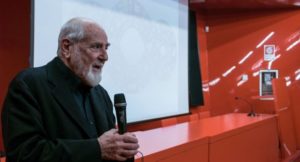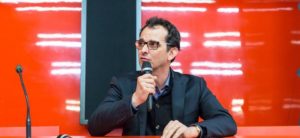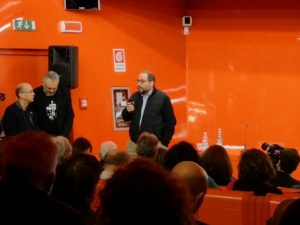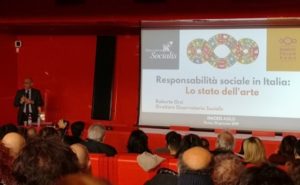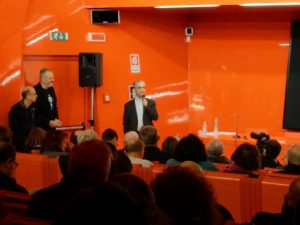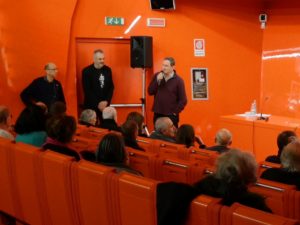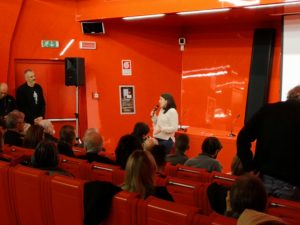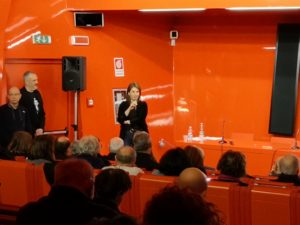The rehearsals, the behind the scenes, the theatre, the props, the actors, the script, the audience and the performance: these are the pieces composing the complex puzzle of the Rebirth Forum Rome, held from 24th to 26th January. It’s not a play, the reference is to the process of production of the Forum, which we will follow step by step to illustrate its peculiarities. The rehearsals are the previous Rebirth Forums, started in Cuba in 2015 and then spread throughout the world, from Milan to Melbourne, from Tirana to Singapore. Not in fact rehearsals, but previous experiences which have supplied precious elements constantly adapted to new geographical, and therefore social, contexts.

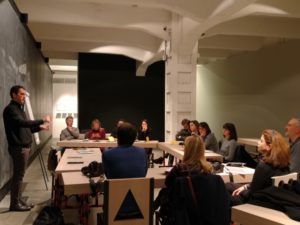
Day 1 – The briefing of the facilitators before the start of the Forum.
We thus get to the behind the scenes of the initiative in the capital, with the preparation, a phase in fact heavily relying on the work carried out and the issues emerged in the previous Rebirth Forums: Cittadellarte organized the event with Macro – Museum of Contemporary Art, with the collaboration of Roma Capitale (assessorate to Cultural Growth) and Azienda Speciale PALAEXPO; the event was also supported by ASviS, Alliance for a Sustainable Development and ROMABPA, Roma Best Practices Award.
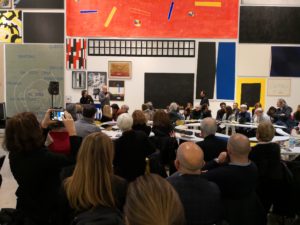
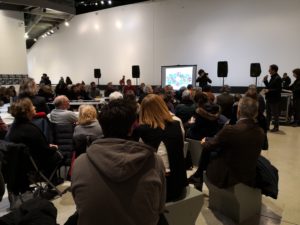
Day 1 – The start of the Rebirth Forum
Theatre of the event was Macro Asilo, an ‘active’ background, a feature made obvious by the presence of Giorgio de Finis, who participated in the Forum in the double role of artistic director of the museum and Rebirth/Third Paradise ambassador. The props were mainly two: the tables of the Third Paradise, created by Michelangelo Pistoletto in collaboration with Saverio Teruzzi, around which the work tables took place, and the chairs, which, as indicated by the organizers, were brought by the participants. Nothing was left to chance. Even the chairs used were each coming from the association or body the participants were representing. The result was a mobile, collective, colourful and, above all, live work of art.

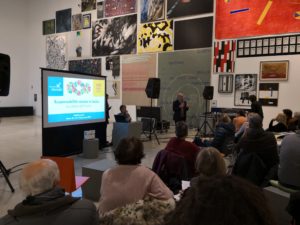
Day 1 – At the microphone, from the left: Paolo Naldini, director of Cittadellarte; Roberto Orsi, director of Osservatorio Socialis.
We then had the actors: 86 referents from as many organizations of different types (institutions, bodies, associations, businesses, profits and nonprofits), almost all of them with headquarters or branches in Rome. None of them had to act: led by Paolo Naldini (director of Cittadellarte), Saverio Teruzzi (coordinator of the Rebirth / Third Paradise ambassadors) and the facilitators, the participants debated around the work tables in groups of ten, exchanging and sharing reflections, proposals and experiences – also in reference to their organizations – from which to formulate actions aimed at a common good, contextualizing them in the Roman area.
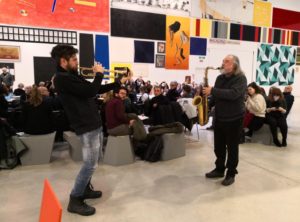
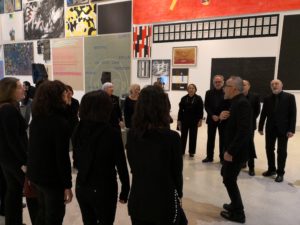
Day 1 – The artistic performances opening and closing the first day of the Forum, from the left: Johnny Lapio and Pasquali Innarella during the ‘Two-people Dialogue in the Third Paradise’ and the Choir of Piazza Vittorio.
The script was once again aimed at triggering a responsible social transformation, starting from art, or more precisely the Art of Demopraxy. The demopractic method was the key to the whole process, directed at identifying sustainable practices and projects for the organizations active in Rome and its province. As mentioned in a previous article, the demopractic method adopts the UN’s 17 Sustainable Development Goals from their 2030 Agenda as main reference to define the main fields of action in connection with local needs; it also develops as a cognitive, planning, participatory and performative instrument articulated in three operative phases (Mapping, Forum and Working Sites). Here is where the Rebirth Forum comes into play, whose model proposes and activates a dynamics of commitment in which everybody is called to take part in first person, in the awareness that we are all invested with social responsibilities in the organizations we participate in and belong to.
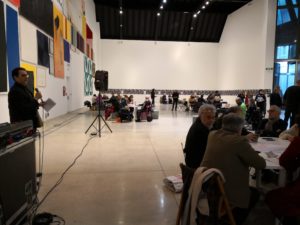
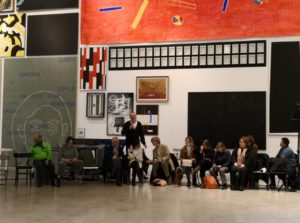
Day 2 – Paolo Naldini’s and Saverio Teruzzi’s speeches started the proceedings
On the third day of the Forum, what had emerged in the course of the plenary conference was presented to an audience crowding one of the rooms of the museum. The speakers of the occasion were: Saverio Teruzzi, who introduced and moderated the event; Giorgio De Finis; Paolo Naldini; Michelangelo Pistoletto; Roberto Orsi, director of Osservatorio Socialis, Stefano Firpo, general director of MiSE; Gianni Rosas, general director for Italy of ILO – International Labour Organization; Franco Bernabè, president of the Italian National Commission for UNESCO; Maria Teresa Pisani from UNECE; Roberta Fusacchia, director of Giovani e Volontariato at the Italian Red Cross association; Luigi Ferrata from ASviS and Paolo Masini, who launched the new edition of Roma BPAward, assigned to the best practices in the capital (please see the picture gallery of the speeches below this article).

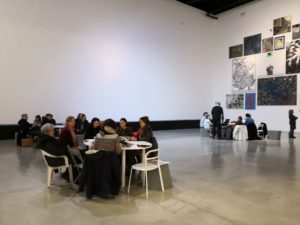
Day 2 – The work tables.
We then get to the actual performance: the Forums aim at creating a product of political, social and economic design, relying on a method for the development of a responsible and sustainable organizational model in reference to the UN’s 17 Sustainable Development Goals. 86 organizations, 10 work tables and 4 key questions on which the discussion centred: “How are the SDGs relevant to your organization?”, “In relation to your experience and inclinations, what could be the areas of intervention in connection with goal 11 (sustainable cities and communities)?, “How can you include goal 11 in your organization with immediate effect?” and “How can we maintain the network and organize the working sites?”. The debate around these issues led to the identification of common plans of action to carry out in the next 12 months; a process which – according to the participants – requires a certain knowledge of the territory, an education suitable to the evolution of the context, even if informal, and an active involvement, from the museum to the suburbs.
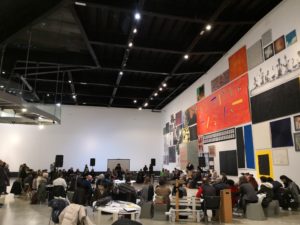
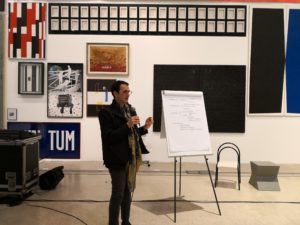
Day 2 – From the left: the plenary and Paolo Naldini.
With regard to the third question (“How can you include goal 11 in your organization with immediate effect?”), the answer was: “With art, as a bridge towards the outside of the organizations and an instrument of care and redevelopment; engaging young people, through a communication fitting their age; captivating new audiences, through an informal didactics; educating, creating awareness and encouraging people to take care of their territory”. On this subject, the participants stressed the importance of the mapping process and the creation of a network of incentives to act socially responsibly. Micro-forums and sectorial forums were instead identified as the best way to maintain the network and manage the working sites. In agreement with Macro Asilo, a date has in fact already been set for the meeting that will activate the diffused planning of the working site of the Rebirth Forum Rome: it will be on Thursday 7th March from 15.00 to 19.00 in the Forum Hall.


Day 2 – From the left: MaTeMù’s collective performance and the final meeting of the facilitators.
“If I had been asked on Thursday 24th, just before starting, how I would have liked the first Rebirth Forum Rome to go, I probably would have been happy with something less than it actually was! – exclaimed Saverio Teruzzi (pictured on the left with Giorgio de Finis during the final conference) – It was a success both from an organizational point of view and in terms of the results achieved. Rome’s response was important. The decision to collaborate with Macro Asilo and the Third Paradise ambassadors was a winning choice.
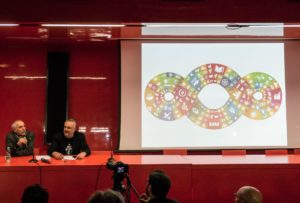
I was expecting interest from the world of art and the third sector, but the presence of the City of Cerveteri, VI Municipio, Azienda Speciale PalaExpo, both traditional and extremely innovative farming businesses, the so called ‘informal people’ from academies, parks, service companies, etc. presented the image of a lively ‘extended’ Rome, stretching beyond the boundaries of the metropolitan city and the Lazio region. 86 organizations officially registered, others only participating, tables composed on the spur of the moment bringing together experiences, knowledge, projects that will constitute the basis of opportunities of a ‘doing’ centred on the UN’s 17 Sustainable Development Goals from their 2030 Agenda, which the working sites will manage and implement. I really want to thank everybody, but in particular Pasquale Innarella and Johnny Lapio, who opened the event with their sax and trumpet; the Choir of Piazza Vittorio, who closed the first day; the Mate Club Dance, who literally had everybody dancing; and Giancarlo Cardini, who drew the curtain on the event with an exceptional piano performance. Now the working sites, we are ready”.
The video-comment of Paolo Naldini, director of Cittadellarte.
Please click here to watch all the video-interviews with the protagonists of the Rebirth Forum Rome.
Day 3 – Picture gallery of the events:

